A name conveys so much more than mere description. For example, there’s a certain cachet to the label “exotic.” Generally, this gets at the idea of exclusivity or “coolness.” The prestige quickly evaporates, however, when one follows up with “alien.” This combination leaves a decidedly sour taste. Everyone has to be from somewhere, so it’s a little unkind, but to be known as an alien is to be known as not from here, to be incongruous—to not be welcome. Everyone wants to be loved but aliens are universally forsaken. It’s especially hard when an entire species is scorned. The scientific name I’m talking about here is Halyomorpha hayls. The P.R. problem only grows worse when the common name, “stink bug,” is applied.
Despite their repugnant reputation, to me stink bugs have a certain perky charm. You see, they display exceptional—and somewhat surprising for insects—parental concern for their offspring. They frequently protect egg clusters or newly hatched nymphs from predators and external threats. I offer, as an example, the following excerpts while eavesdropping on a mother brown marmorated stink bug lecturing her assembled children about the dangers of stink bug life in a human world:
“You’ve got to be careful, my children,” the matriarch warns. “The human species does not like insects, even though we represent more than half the animals found on earth. Gather around and listen carefully. ” Antennae twitch and stick-like legs shift restlessly as the youngsters focus their attention. Mother now takes on a more serious mien:
“We are unable to live without prejudice among the human species,” she says. “They will never accept us. Even though it’s mankind who brought our ancestors here—we never asked to come—humans despise our presence. They have so much, yet they’re unwilling to share the warmth of their homes in winter or the nourishment of their crops to survive. Stay away from people as much as possible. In their gardens and fields, work only under the cover of darkness. In their homes, stay within the protection of walls and crevices—never show yourselves to the open light.” The babies grabbed on to these warnings like the revealed word of God.
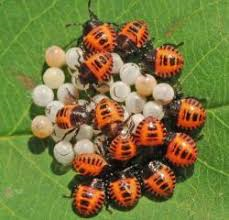
Drawing herself up into a commanding presence, “When it comes to humans, there is no sympathy, there is no compassion. If you are ever discovered, defend yourself immediately with your stench, then scramble for the nearest cover or concealment you can find.” Finally, she fixes them with her most imposing insectile stare. “Beware humans with vacuum cleaners—survival depends on quickly separating yourselves and scattering in opposite directions.”
The brown marmorated stink bug—the focus of this essay—is a relatively recent addition to the list of insects that populate Texas. And why not? It’s a great place to live. Of the approximately 100,000 species of bugs native to the United States, more than 1/3 are found here in Texas. In fact, Texas has more different species of insects than any other state.
In South and East Texas, the primary stink bug species is the southern green stink bug, then followed by the green stink bug. The brown marmorated stink bug (“marmorated” means veined like marble) is currently in third place and is the only non-native species. Here’s a simple warning: do not step on them. To smell the discharge of a stink bug is to not care about which species you have disturbed . . . they all stink horribly! If you find them in your home and suck them up with your vacuum cleaner—you’ll only do that once. Hell hath no fury like a concentration of frightened stink bugs!
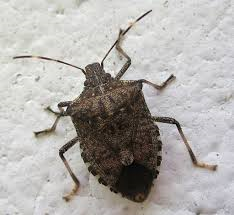
So how do you recognize brown marmorated stink bugs? First of all, they have a shield shaped body like all stink bugs. They are mottled brownish gray in color and are between 15-17 millimeters long. There’s a little white band around each antenna and the legs are faintly banded in white as well. Abdominal segments are alternatively banded black and white. The underside of the bug is white, sometimes with grey or black markings. The bug’s width and the way its legs extend outward from the sides make it seem larger than it actually is. And as if that isn’t enough to intimidate you, they also have wings, which they fold on top of their body while at rest. People easily get them confused with assassin bugs or “kissing” bugs.
The first of this species of stink bug was accidentally imported to the Allentown, Pennsylvania region in the late 1990’s. They are native to Japan, China and Korea—and have no natural predators in the U.S. The brown marmorated was thought to then be brought to Corpus Christi on an RV that had traveled from Pennsylvania (they thrive on the warm winters in Texas). They have since also established themselves in Europe and South America.
So what’s the big deal about brown marmorated stink bugs? While the stink they emit is unpleasant, the real problem is they ruin cash crops as well as backyard gardens. They are known fliers, and are incredibly good at it—flying up to 3 miles a day. Their wings are so powerful that you can usually hear them fluttering around if they are in your home. They have been known to destroy fruit, cotton, corn, grain sorghum and soybean crops, even nuts and various other vegetation. It’s not that these pests “eat” vegetables and crops, rather, they suck out all the moisture and thereby destroy them. Their mouth parts work like little sippy straws and almost anything that grows is at risk. When stink bugs feed on corn they go through the husk before eating the kernels, hiding the damage until the husks are removed during harvesting. The same damage is seen in soy beans, as the stink bug goes through the seed pods to acquire the juices of the seeds.
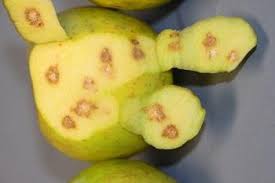
Stink bug egg masses can be found underneath leaves and on stems of low growing vegetation. The white or green barrel-shaped eggs are massed in groups of 30-100. After 35-45 days the hatch is at its most noticeable because the nymphs hang around for a few days under the leaf. Nymphs are yellow and red with red eyes. As they grow, the yellow turns a maggot-like off-white. Female stink bugs are capable of laying 400 eggs in their lifetime and produce multiple annual hatches in Texas’s warm climate.
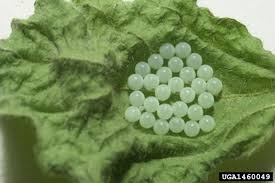
Brown marmorateds are mostly outdoor insects, however, they seek the warmth of structures in winter. They are common in attics and the various cracks and crevices around all homes. In the summer months, though, they can often be found in large numbers on the sides of buildings and around windows and doors. If you discover them in your home (where you find one there will be more—they use pheromones to attract others), they are very difficult to eradicate. If you have the patience, consider making your own DIY traps. Use a small lamp and a tub of soapy water underneath. Stink bugs—despite warnings from their mothers—are attracted to light . . . but cannot swim. Takes longer than a vacuum cleaner, but a lot more pleasant.
Outdoors, they represent a major agricultural challenge. According to Rutgers University Extension Service, “there are no viable strategies for control of the brown marmorated stink bug. The use of insecticides has a very short-lived effect and there is evidence of resistance development. Even where insecticide is effective, repopulation occurs through migration from non-treated areas.”
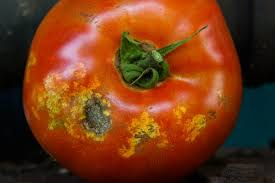
If stink bugs had emotions, they would be ravaged by nightmares of a baby killer named Trissolcus japonicus. This Samurai Wasp, a parasitoid wasp from China, is a primary predator. This wasp lays eggs directly into the eggs of marmorated stink bugs. The ensuing carnage is straight out of a Sci-Fi horror flick with wasp larvae bursting forth from within the egg mass and devouring everything stink bug related in the process. In an insectoid version of Breakfast at Tiffany’s, newly minted male and female wasps, fully sated after this carnal gluttony, have sex and get on with finding the next party! You Tube video found at: https://www.youtube.com/watch?v=rbdXiiM538I
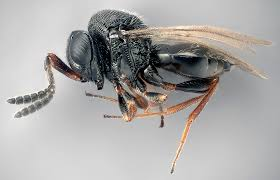
Samurai Wasps are currently being studied as a biological control for marmorated stink bugs. Because the species Trissolcus japonicus is not native to the U.S. researchers are concerned with the possibility that japonicus might become an invasive species with no native predators of its own. The research populations of T. japonicus were kept under tight controls but in 2014, some wasps were discovered in the wild, just outside of Washington, D.C., in a Maryland suburb. Then in October of last year, T. japonicus was found in two small clusters in Vancouver, Washington, by a field technician with Washington State University. Genetic analysis showed the two groups were unrelated to those under quarantine study. It appears there’s a price for everything!


